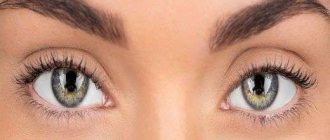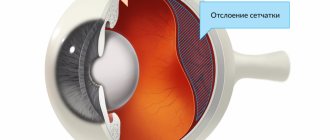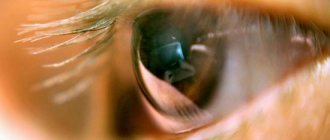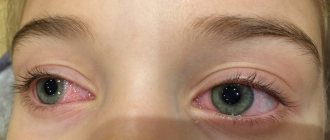Feeling sand in your eyes
Under normal conditions, the mucous membrane of the eyes has a three-layer coating of tear film. This performs very important and protective functions. The main ones include:
- hydration;
- elimination of irregularities on the cornea;
- nutrition of eye tissues.
The blinking process is also very important. This helps to distribute the tear fluid evenly throughout the membrane. Thus, the eyes are protected from small particles, dust particles, specks and grains of sand.
Many factors can cause disruption of tear production. A violation of its stability may also occur. As a consequence, dryness of the conjunctiva and drying out of the mucous membrane occurs. The eyes begin to suffer from lack of oxygen. Nutrition in tissues is disrupted.
In most cases, dryness causes the feeling of sand in the eyes. Such unpleasant symptoms can also occur when a foreign body, small particles or dust enters the area. Therefore, the etiology of such manifestations can only be determined after a full examination. Sometimes a visual examination is enough for the ophthalmologist.
Doctors and diagnostics
When the first warning signs appear, the patient should contact a medical professional. The treatment of eye diseases is carried out by an ophthalmologist who works in almost every clinic or outpatient clinic.
If the onset of a symptom is caused by the entry of a foreign body while performing professional duties, then you can contact the company’s medical center, since this happened at work. A paramedic or nurse has basic skills in caring for patients with eye injuries.
When visiting a doctor, an eye examination will be performed and, if necessary, a comprehensive examination will be prescribed. As a rule, it includes laboratory and instrumental studies. After analyzing the data obtained, the doctor will prescribe medication.
Causes
If your eyes feel like there is sand in your eyes, you should determine the cause of this phenomenon. The organ of vision is covered with a protective tear film, which is responsible for hydration. When blinking, tears are distributed evenly over the surface of the mucous membrane. It often protects the eyes from foreign objects. But sometimes this may not be enough.
Due to various reasons, the tear layers can become thinner. Against this background, drying out and tissue nutritional deficiency may develop. This causes a feeling of sand in the eyes. The reason may lie in the development of pathological processes or physiological factors.
The main reasons for the occurrence of such unpleasant symptoms:
- incorrectly selected contact lenses, first use of such products or their low quality;
- Excessive strain on vision – long periods of working at the computer, watching TV, reading;
- exposure to strong wind or dry air on the eyes;
- influence of sunlight;
- adverse reactions due to taking ophthalmic medications;
- getting water with impurities of chemical elements into the eyes (from the water supply or swimming pool), especially chlorine, which irritates the mucous membranes;
- overwork, constant lack of sleep;
- hormonal changes (mainly occur in women during pregnancy and menopause);
- age-related changes.
Elderly patients often experience these symptoms. The reason lies in the development of irreversible processes. Local metabolic processes are also disrupted and oxygen supply is reduced.
Patients whose work activities involve contact with chemicals and household substances are at risk. Sometimes minor burns can cause unpleasant symptoms. At the same time, the eyes hurt and redness appears. The patient needs medical attention.
Sometimes the cause of the feeling of sand in the eyes can occur due to a minor injury. For example, damage to the mucous membrane by metal particles. Pain, burning, and redness appear. Sometimes such particles can come out of the eyes on their own along with tears. But if it damages the membrane, then the help of an ophthalmologist will be required.
How to get rid of dryness and sandy feeling, how to treat it
To get rid of the symptoms of dryness and irritation in the eyes, you need to determine the cause of the pathology.
Treatment will depend on the factor that caused the disease. Hormonal agents are used in cases of non-infectious inflammation.
Prescribed when other medications do not help. The main active ingredient is synthetic steroids. Hormonal drops are ineffective in treating inflammatory phenomena caused by bacterial, viral, or fungal infections. Long-term use of hormonal drops causes cataracts and glaucoma.
Eye drops containing antibiotics are an effective way to combat bacterial infections. Medicines are available in the form of eye drops, gels, and ointments. But why Dexamethasone eye drops are prescribed and how effective this remedy is is indicated here.
The list of antibacterial eye drops to treat the disease includes:
- Tsiprolet;
- Tobrex;
- Phloxal;
- Levomycetin.
Antibiotic ointments for eye pain
Ointments containing an antibiotic if your eyes hurt, water, and feel like there is sand in them:
- Tetracycline;
- Dexa-gentamicin;
- Erythromycin.
To enhance antibacterial therapy, combination drugs are used, which include an antibiotic and a hormone: Eubital, Maxitrol, Sofradex
Please note that tetracycline ointment has instructions for use and must be followed
Antiviral drugs, such as Oftalmoferon, Actipol, are used for adenoviruses and herpes.
Hormonal, antibacterial and antiviral eye drops should be prescribed and supervised by a doctor. They cannot be used without identifying the pathogen. Self-medication can lead to serious complications with vision and health.
Anti-inflammatory non-steroidal drops based on Diclofenac are used for non-infectious conjunctivitis.
Cause of the inflammatory process: exposure to external factors. These include increased visual stress and dry air. Non-steroidal drugs Diclofenac, Indocollir, Diklo F are used as prescribed by a doctor according to the instructions.
Artificial tear drops are used to restore the tear film. Before using Indocollir eye drops, read the instructions!
The principle of action of these drugs is based on several principles: creating a film that prevents evaporation or a film that replaces tear fluid.
Eye drops to treat if your eyes are sore and watery
- Oxial and Blefarogel contain Hyaluronic acid, similar to tear fluid.
- Chemo-comod, Visin Clean Tear and Slezin are surface-active polymers that retain natural moisture. The advantage of Chemo-commoda over other moisturizers is that they can be used without removing contact lenses, so they can be called eye drops for lenses.
To compensate for the increased visual load when working at a computer, special computer glasses are used. Purpose of glasses: adjusting the color spectrum and removing glare on the monitor screen. Multilayer lenses have double protection and are available in diopters for nearsighted and farsighted people.
Factors such as the location of the monitor and lighting also affect the eyes when working at a computer for a long time. Deviation from the required standards can cause eye pathology.
Food should have enough vitamin A, C, zinc and lutein. These substances are a necessary component of cellular metabolism and affect visual acuity.
You should start taking medications by studying the instructions. If there are indications of possible disturbances on the part of the visual organs, then this must be taken into account. If you experience symptoms of dry eyes, consult a specialist.
Wearing soft lenses requires strict adherence to hygiene and care rules.
Dry eyes can be a symptom of infection, low humidity, or visual strain. Lenses and medications can also cause inflammation of the mucous membrane and cornea. Before using this or that drug, you need to find out the cause.
Anti-inflammatory, moisturizing and film-protecting eye drops will help relieve painful sensations in the eye. Products that are good for the eyes, organization of the workplace and computer work schedule, glasses will be a preventive measure against the occurrence of pathology.
Diagnosis by a doctor
When contacting an ophthalmologist, a visual examination is initially performed. The doctor then examines the patient's medical history to rule out chronic diseases. Taking into account the patient's complaints, diagnostic methods are prescribed.
They mainly consist of the following procedures:
- measurement of intraocular pressure;
- ophthalmoscopy to examine the fundus of the eye;
- biomicroscopy will help to study the condition of the cornea;
- determination of visual acuity;
- MRI, CT scan of the brain (prescribed for suspected severe diseases);
- X-ray is necessary to determine the location of the foreign body.
After a complete diagnosis, the doctor can determine the treatment method. If you suspect the development of diabetes mellitus, laboratory blood tests and additional consultation with a specialized specialist will be needed.
Treatment
Treatment should be prescribed by an ophthalmologist after a full examination. When dry eye syndrome develops, the patient is prescribed drops that are substitutes for natural tear fluid. The following drugs are considered effective: Natural tear, Hypromellose. Additionally, medications may be prescribed to accelerate tissue regeneration.
As a rule, ophthalmologists select and prescribe specialized moisturizing drops, and as mentioned above, “tear substitute” drops, the general name for such drugs “artificial tears,” are effective. The composition of the drops is as close as possible to natural human tears. They moisturize for a long time, relieve the feeling of sand in the eyes, dryness, and often relieve symptoms such as redness of the eyes and unpleasant itching, for example, when wearing contact lenses.
When choosing moisturizing drops on your own, you need to pay attention to the composition of the drug. Preparations without preservatives are safer as they do not cause allergic reactions. These drops include:
Cationorm
Cationic unique emulsion to moisturize the eyes. It restores all three layers of the tear film, permanently eliminating severe, intense discomfort, dry eyes (during the day and in the morning), and the sensation of foreign particles in the eyes. Cationorm does not contain preservatives, which means it can be used in conjunction with contact lenses. It retains the moisturizing effect for a long time and completely eliminates the feeling of sand in the eyes.
Prescribed for: people with severe complaints of dryness, a feeling of sand, eye discomfort; also for people who wear contact lenses for a long time (more than 6 months, more than 5 days a week and/or more than 10 hours a day); people with other eye diseases that cause a sensation of foreign particles (glaucoma, blepharitis, allergic conjunctivitis); people using hormone replacement therapy.
Okutiarz
Eye drops with ultra-high molecular weight hyaluronic acid also do not contain preservatives. Ocutiarz is convenient for quickly eliminating pain, a feeling of sand in the eyes, discomfort and eye fatigue that manifests itself at the end of the day after intense visual work.
Okutiarz is stored for 6 months after opening the bottle. The drug can be safely instilled onto contact lenses; it is also often used to eliminate discomfort after ophthalmological operations on the cornea.
Prescribed for: people with complaints of a feeling of sand and dry eyes occasionally, in the evening, after intense visual work (computer/office syndrome in office employees, motorists/motorcyclists, frequent fliers, travelers, students); people who have recently worn contact lenses are just learning to use them (to make it easier to remove and put on lenses); people within 6 months after eye surgery (LASIK, PRK, cataract extraction).
Oftagel
Eye gel with carbomer in maximum concentration. It moisturizes for a long time, eliminates the feeling of sand for the whole day, and also fights excessive tearing and does not require frequent instillation. Can be used once at night if it is not possible to instill moisturizing drops during the day.
Prescribed for: people with complaints of periodic dry eyes and/or lacrimation and reluctance/inability to instill drops more than once a day.
It is worth considering that all medications can be taken only after a doctor’s prescription. Self-medication can negatively affect the condition of the eyes and the patient’s well-being. In addition, it is strictly forbidden to exceed the recommended dosage.
If there are inflammatory processes, you will need to take antibiotics, antihistamines and antiviral drugs. Allergic reactions of varying degrees of complexity may require the use of glucocorticoids and corticosteroids.
If unpleasant eye symptoms occur against the background of endocrine or neurological diseases, then they must initially be cured. Drug therapy is prescribed by a doctor only after confirmation of the diagnosis.
Diagnosis and treatment of the disease
The main sign of dry eyes is a feeling of sand, often accompanied by pain in the organs of vision. In cases where the eyes hurt, as if sand had been poured in, special measures are prescribed, the purpose of which is to eliminate the discomfort. For this, the following diagnostic measures are prescribed:
- Schirmer test. The study allows you to determine the rate of tear fluid formation.
- Fluorescein instillation test. During the diagnostic process, a special staining liquid is used, with which it is possible to detect open areas of the cornea and damaged areas of the tear film.
- Norn's test. Determines the quality of the tear film and the rate of its evaporation. Based on the results of these studies, the doctor makes a diagnosis and prescribes medications.
First of all, it is necessary to eliminate the factors that provoked the development of the disease and take the necessary actions aimed at restoring timely and high-quality hydration of the cornea. This will help maintain the integrity of the tear film and prevent the occurrence of more serious pathologies.
Eye drops and anti-inflammatory drugs
When diagnosing dry eye syndrome, special drops that have a moisturizing effect are prescribed. The procedure is carried out twice a day; at the end of the course of therapy, an improvement in the condition of the eyeball is observed, its surface is restored and a strong tear film is created.
A mild form of this pathology is treated with drops that have a low degree of viscosity. For moderate and severe disease, medications with a medium or high level of viscosity are prescribed when pain and discomfort are not the only signs.
Quite often, for dry eyes, experts prescribe anti-inflammatory medications, which are sometimes supplemented with antihistamines. Surgery is performed only as a last resort, when there is an urgent need to significantly increase the amount of tear fluid.
There are several types of fairly effective eye drops that can cope with a similar problem in a short time. These may be the following drugs:
- Antibacterial: Levomycetin and Albucid. The action of these drugs is aimed at relieving irritation of the eyeball.
- Moisturizing: artificial tears or Santa. The drops have a moisturizing effect and can eliminate the feeling of sand poured into the eyes.
- Keratoprotectors: Korneregel, Defislez and other drugs of similar action. Medicines are prescribed when the cornea is injured due to wearing contact lenses or a foreign body entering the eye.
Folk remedies for dry eyes
Folk remedies can only be used as additional therapy and do not replace drug treatment carried out under the supervision of a physician.
Traditional medicine suggests treating dry eyes with rinses or compresses. The simplest option is a compress with tea leaves. To do this, you need to brew strong tea, cool slightly and soak a cotton pad with warm liquid. Apply the compress to closed eyes and leave for 10-15 minutes. The procedure is carried out 2−4 times/day. The course of treatment is determined by the condition of the visual organs and lasts on average 7-10 days. For the same purpose, decoctions of medicinal plants (calendula, sage, chamomile, etc.) are used.
Washing is carried out using marshmallow root. To do this, take 1 part of crushed raw materials and 2 parts of boiled water. The root is poured with liquid and left for about 8 hours, filtered. Use to wash the eyes 2-3 times a day, usually in the morning and before going to bed.
Treating sand in the eyes with honey-based drops has shown quite high effectiveness. Water and honey are mixed in a 2:1 ratio and the resulting solution is dropped into the eyes.
However, be careful as the safety of this method has not been established. Honey is a highly allergenic product and, in the presence of an inflammatory process, can contribute to increased pathology and the development of complications.
https://youtube.com/watch?v=2WR_40W8NOM
Prevention
Prevention is intended to prevent the development of ophthalmic diseases. But it is important to consider that they must be observed regularly. To avoid the development of unpleasant symptoms, you should follow simple rules and recommendations. These include:
- compliance with safety rules when working with hazardous substances (chemical elements, household substances, exposure to cold, hot, dry air);
- proper, complete and vitamin nutrition;
- the use of moisturizing drops during prolonged reading and computer work;
- use contact lenses made of high-quality materials and properly care for them;
- consult a doctor in a timely manner;
- wear safety glasses in sunny weather;
- to refuse from bad habits;
- lead a healthy lifestyle.
It is forbidden to self-medicate, since any signs from the eyes may indicate the presence of serious pathological processes. It is also not recommended to use folk remedies without a doctor’s recommendation. This can cause various consequences, especially the development of an allergic reaction. If suspicious symptoms occur in children, you should not provide assistance yourself. You should go to the emergency room immediately. At this age, foreign bodies often enter the body.











